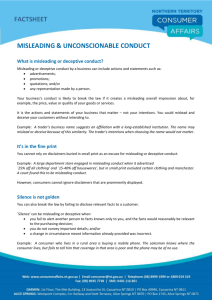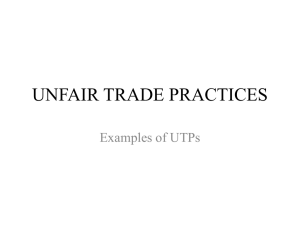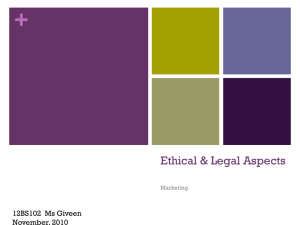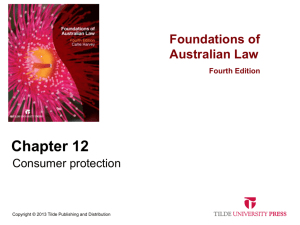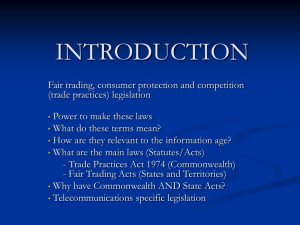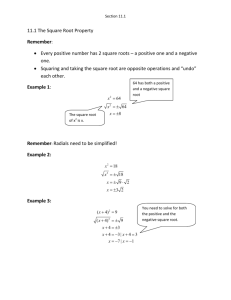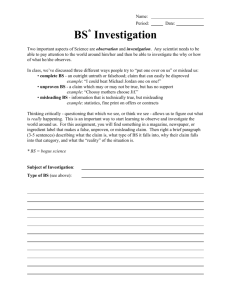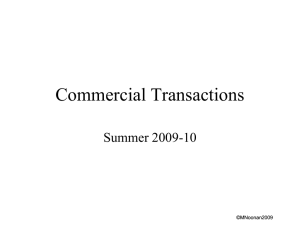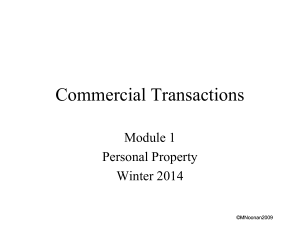Misleading, Deceptive Conduct
advertisement
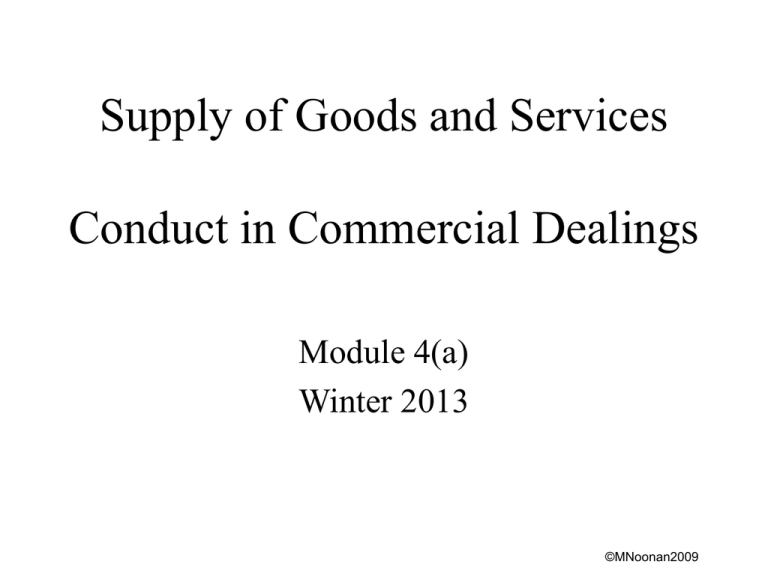
Supply of Goods and Services Conduct in Commercial Dealings Module 4(a) Winter 2013 ©MNoonan2009 This presentation and Copyright therein is the property of Maureen Noonan and is prepared for the benefit of students enrolled in the Commercial Transactions course conducted by the Law Extension Committee and is available for their individual study. Any other use or reproduction, including reproduction by those students for sale without consent is prohibited. ©MNoonan2009 Types of transactions considered Conduct in Commercial dealings • • • Some conduct is proscribed for all commercial dealings whether B2B or B2C. E.g. misleading and deceptive s. 18 ACL Some with respect to B2C only. E.g. unfair terms in standard form consumer contracts (ACL), or ability to exclude terms implied by 18,19,20 SOGA Some is in between-restricts some, but not all B2B arrangements and B2C transactions e.g. unconscionable (ACL) ©MNoonan2009 Topics 5(a) Misleading & deceptive conduct 5(b) Unconscionable conduct 5(c) Unfair contract terms in consumer standard form contracts ©MNoonan2009 Misleading and deceptive conduct • ACL Part 2-1s.18. • In Winter13 Semester, s. 19 (exceptions for information providers) not covered. • Similar to TPA s. 52. This provision and cases decided in relation to it relevant to ACL s.18. ©MNoonan2009 s.18 ACL 18. Misleading or deceptive conduct (1) A person must not, in trade or commerce, engage in conduct that is misleading or deceptive or is likely to mislead or deceive. (2) Nothing in Part 3-1 (which is about unfair practices) limits by implication subsection (1). ©MNoonan2009 s.52 TPA 52 (1) A corporation shall not, in trade or commerce, engage in conduct that is misleading or deceptive or is likely to mislead or deceive. (2) Nothing in the succeeding provisions of this Division shall be taken as limiting by implication the generality of subsection (1). ©MNoonan2009 Conduct Doing or refusing to do any act and includes: • Representations and promises • Exaggerated sales talk • Silence • False warranties or guarantees Objective test Real and not remote chance of misleading/deceiving Confusion not enough Exclusion clauses cannot be relied upon but disclaimers can be effective if they modify the “conduct” so it is not misleading or deceptive. E.g. disclosing that one is passing on information supplied by another without any knowledge or belief in its truth or falsity…art galleries, real estate agents. ©MNoonan2009 Misleading, Deceptive Conduct Not limited to consumer. No need for intent. Endless application. e.g. use of another trader’s distinctive words, products, features, slogans, similar business names, defamatory comments, misleading conduct in employment, representations in connection with sale of real estate, businesses, goods, services, silence where there is an obligation to disclose. ©MNoonan2009 s.18ACL and s.52TPA compared s.52-limited to corporation due to constitutional limits. Mirror provisions for non corporations in State Fair Trading Acts. s.18-uses person. Not limited to corporations because of State and Federal agreement to have single law Must still be in trade or commerce. Not limited to consumer transactions ©MNoonan2009 Elements Prove on the balance of probabilities: • Conduct engaged in. (Note difficulties with oral conduct without corroboration) • Conduct conveyed a certain meaning. May be unambiguous or context may be relevant. • The meaning conveyed was misleading and deceptive. ©MNoonan2009 In Taco Bell Inc. v. Taco Bell Pty Ltd (1982) 42 ALR 177, the Australian Federal Court suggested a 4 step approach • • • • Identify the relevant section of the public who may be misled or deceived. The relevant section may be the public at large. Whether the conduct is misleading or deceptive must then be judged by the effect of the conduct on all those who fall within the relevant section of the public; the shrewd and ingenuous, the educated and uneducated, the experienced and inexperienced. Conduct will not, however, be misleading or deceptive if it would only mislead incredibly stupid persons and in most cases, the question will be whether a reasonable member of the relevant section of the public would be misled. Evidence that consumers are in fact suffering from a misconception may be persuasive but is not essential. It must be established that the misconception has arisen as a result of the conduct complained of and not some other factor. Note: Intent of defendant not relevant. Not enough to cause mere confusion. The conduct must actually mislead or deceive, or be likely to. That is a point of difference with a passing off action…where it is enough to establish that it is confusing. ©MNoonan2009 Considerations Is puffery –superlative or comparative that is a self evident exaggeration, (normally found not to be a misrepresentation or contractual term at common law) excluded?-Not necessarily. Can s.18 liability be excluded by use of an exclusion clause? No, (as with s.52TPA) but a disclaimer (designed not to exclude s. 52, but to prevent liability arising by preventing the relevant conduct being construed as misleading or deceptive…communicating information such that they are not misled at all or did not rely on it)…or an indemnity can achieve a similar effect. ©MNoonan2009 SEELEY INTERNATIONAL PTY LTD V. CINTRO PTY LTD (Newtronics) 2002 ASAL 55-075 and text extract Seeley made domestic rooftop evaporative airconditioners and contracted in 1992 with Newtronics to design a radio frequency control unit to safely and satisfactorily control the on off function. In 1994, Seeley contracted with Newtronics to manufacture 3,000. Seeley believed them safe and unaware that overheating and fire were possible if it failed. 3 fires occurred. It was found that Seeley relied on expertise of Newtronics and terms of fitness for purpose and merchantable quality implied into contract by SA SOGA. Also claim that s. 74 applied. Newtronics said it only applied to “services”. Found that Newtronics was contracted to design and manufacture remote control package to be integrated into the AC….design, not merely supply=services. Note onus of disproving S was a consumer was on N. Also found a breach of duty of care and misleading and deceptive conduct because they did not have the expertise and competence they represented that they had. ©MNoonan2009 Can silence be misleading? Metalcorp sold 77 tonnes of scrap copper cathode to MML. The companies had been doing business together for 10 years. The copper had been stolen from Western Mining (WMC) by persons unknown but had been acquired in good faith by Metalcorp from a third party with whom it had previously dealt.WMC informed MML about the theft and its suspicion that the copper had been stolen. MML inspected the copper after delivery, noticed that less than promised had been delivered and saw evidence it had been manufactured by WMC. MML passed this info to WMC by fax at 8.51am on Feb 2, 2001.The established arrangements between Metalcorp and MML were that deliveries by Metalcorp were quarantined until inspected and accepted and there was a procedure for disputes as to quality. During a telephone conversation between Metalcorp and MML about 9am on Feb 2, 2001 MML said that it had inspected the copper and asked about the short delivery. Metalcorp advised that it had received all the copper available. MML believed the copper stolen but said nothing about its belief, the theft WMC had advised it about, or the evidence it had found on inspection and had passed on to WMC. Metalcorp believed that, as a result of the 9am conversation, MML had accepted the copper and intended to pay for it. At 11.30am that day, it gave a cheque to the company which supplied it. MML refused to pay. Metalcorp was unable to recover the money it paid the supplier. Metalcorp Recyclers P/L v. Metalmanufacturers 2003 NSWCA 213 ©MNoonan2009 Metalcorp sued MML for misleading or deceptive conduct in breach of s. 52 TPA…in failing to inform it during the 9am conversation, after inspection, that it believed the copper was stolen and that it would probably not pay. In the normal course of events, (common law nemo dat rule) Metalcorp could not have expected to recover anything because it could not give good title. CA (Handley JA, Hodgson JA, Gzell J; : A finding of misleading conduct is open where the conduct, word or deed conveys a misleading impression.The misrepresentation was conveyed by silence. Silence is to be assessed as a circumstance…have regard to all relevant circumstances; in particular the commercial relationship between the parties and their procedures. The conduct took place during a critical conversation. The critical conversation took place against the background of the longstanding business relationship…which had generated A substantial degree of mutual trust. The established course of business involved inspection and notification of complaints. In the circumstances, when the only complaint was short delivery, this was a representation that this was the only problem. MML was running no commercial risk, but knew that Metalcorp was about to take delivery of copper which might be stolen without having any idea of the risk it was running. Damages were recoverable because its loss was suffered by MML’s misleading conduct and Metalcorp had acted in reliance upon it. ©MNoonan2009 A suitable remedy, or the only remedy Often, there are multiple reasons for legal liability. Sometimes, one leads to more appropriate or better remedies. On other occasions and for various reasons, there are no other remedies available. ©MNoonan2009 Larrikin Music Publishing v. EMI (Federal Court- various cases 2010) Men At Work’s Down Under contained flute riff from Kookaburra which infringed Copyright. However, damages awarded were not for breach of copyright but for misrepresentations made to royalty collecting societies APRA and AMCOS falsely claiming that Down Under did not infringe copyright in any other work and Larrikin was entitled to all income from exploitation. Actionable…s.52, 82 TPA…found to be 5% income in hypothetical licensing agreement….enabled suitable remedy. ©MNoonan2009 WARNOCK V. ANZ BANKING GROUP LIMITED G322 of 1987 FC( NSW) (1989) 5 Insurance Cases 60-897 Mr W borrowed $39,000 from ANZ under a new lending product-insured personal loans-insured against inability to repay loan instalments because of sickness and accident to $50,000. Policy contained declaration: I declare that I am….in good health and unaware of any illness, disease or physical defect which could result in a claim. Mr. W said that he could not sign the declaration because of his rheumatoid arthritis but was told that the declaration pertained only to life cover. The bank did not draw Mr. W’s attention to the exclusion clause. Subject to the provisions of the Credit Act 1984, the company shall not be liable to make any payments for death, disablement or unemployment caused directly or indirectly as a result of illness or unemployment which exists at or commences within 28 days of the commencement of this insurance. After some time Mr. W’s arthritis flared up and he was unable to meet the loan repayments. Found to be misleading (s. 52 TPA) and to involve lack of due care and skill on the part of the bank manager (s. 74TPA), The damages measured as the cover Mr. Warnock would have obtained had the bank manager told him the truth. i.e. Policy limit of $50,000 less an additional premium of $1,000. Plus an order under s. 87 TPA varying personal loan agreement from inception in to avoid the default complained of as the basis of the cross claim by the bank. ©MNoonan2009 Appropriate Remedies An illustration of a case where it was not possible to imply fitness for purpose because there was not reliance on skill and judgement, but another remedy was available pursuant to ss 52 and 82 of TPA Clyde Industries Pty Ltd v. Golden West Refining Corp (text). Golden West refined gold using a process involving hydrochloric acid. It was important that there was not any fluorine in the acid as glass vessels and condensers were used. Daly Laboratories supplied acid to Golden from CSBP, but needed ore than they could supply. So it turned to Ajax, a division of Clyde. When Golden used the Ajax acid, condensers and vessels were damaged and $62,132.46 worth of solution containing gold was lost. Trial judge found no reliance for the purpose of implying term of fitness for purpose.Found that Golden did not rely on Daly representation that Ajax acid was same as CSFB acid and did not contain fluorine because executives of Golden knew from their own experience that Ajax acid might contain some fluourine. So, this representation did not cause the damage and so no s.82 damages available for breach of s. 52. However, they did rely on the technical data sheet put out by Clyde that the acid may contain up to but not more than approximately 100ppm fluorine. At that level, it would not cause damage. ©MNoonan2009 E-commerce and s. 18 ACL / s. 52 Trade Practices Act Consider also ancillary liability(s.75B…aids, induces, conspires, directly or indirectly knowingly concerned or a party to it).The conduct must have taken place in Australia. Where were the representations made? Normally where they have effect…e.g. misrepresentations by telephone are heard in Australia….relevant conduct is the misrepresentation not the state of mind of those who made it. No need for an active representation to be conduct. In certain circumstances silence can amount to relevant conduct. For example, where information has been provided but is incomplete, where changes have occurred after information has been given or where there is a reasonable expectation that information will be disclosed. Examples of areas for problems in ecommerce: Advertising website design, logos, product description, Domain names Metatags and cyberstuffing-keywords to attract search engines. Linking and framing Distributing software without permission Contract terms Whether conduct is misleading and deceptive is a question of fact to be considered in light of all the circumstances of the individual case ©MNoonan2009 Misleading conduct in IT and ecommerce See ACCC v. Google (2012) FCAFC. Full FC on appeal, found Google responsible for the misleading impression conveyed by some “sponsored link” search results published on its search results page. Found Google was involved at a commercial and technical level in selecting and displaying sponsored links via its AdWords program. Contrast this with an “organic” search result. ©MNoonan2009 Other m&d conduct Apple 4G compatibility Marketing. In the US “Siri” availability. Optus mobile phone plan-conveyed impression it was a maximum $49/mth, when in fact that was the minimum. Yellow Page Marketing BV and Yellow Publishing Limited….misleading faxes and invoices to gain subscribers Harvey Norman promoted sale of 3D TVs with the promise viewers could watch 2010 AFL and NRL grand finals in 3D..when 3D broadcasts not available throughout Australia. ©MNoonan2009 Enforcement • • • • • • • • • No criminal or civil pecuniary penalties Undertakings Sch 1, item 1,Chapter 5, Part 5-1,Div 1 Substantiation notices Sch 1, item 1, Chapter 5, Part 5-1,Div 2 Public Warning Notices Sch 1, item 11,Chapter 5, Part 5-1,Div 3 Injunctions Sch 1, item 1,Chapter 5, Part 5-2,Div 2 Damages Sch 1, item 11,Chapter 5, Part 5-2,Div 3 Compensatory orders Sch 1, item 11,Chapter 5, Part 5-2,Div 4A Redress for non parties Sch 1, item 11,Chapter 5, Part 5-2,Div 4B Non punitive orders Sch 1, item 11,Chapter 5, Part 5-2,Div 5,s.246 ©MNoonan2009 Unconscionable Conduct • NEW-ACL Part 2-2. Sections 20,21,22 • OLD-TPA Sections 51AA,51AB,51AC and ASIC Act equivalents for financial services 12CA,12CB,12CC Quite some difference between new and old provisions. ©MNoonan2009 Unconscionable Conduct s.20-conduct that is unconscionable within the unwritten law (common and equitable) from time to time is unconscionable for the purposes of ACL. s.21-separate statutory liability for unconscionable conduct in relation to the supply or possible supply of goods or services to a person other than a public company. Due to the narrow interpretation of unconscionability in the unwritten law, parliament has clarified its view separately. Not limited by s.20. s.22-non exhaustive list of matters that court must have regard to when considering contravention of s. 21. ©MNoonan2009 Unconscionable Conduct Courts have tended to construe unconscionable conduct as especially heinous conduct in the common law (s.20)…i.e. narrower than government policy. Hence, the specific provisions to guide courts in particular cases (21),(22) and specific provisions covering standard form consumer contracts (unfair provisions Part 2-3). ©MNoonan2009 Unconscionable Conduct 20.(1) A person must not, in trade or commerce, engage in conduct that is unconscionable, within the meaning of the unwritten law from time to time. (2) This section does not apply to conduct that is prohibited by section 21. ©MNoonan2009 ACCC v. Lux Pty Ltd re scope of TPA 51AB An agent of Lux came to the Standings residence to service an old vacuum cleaner. Mrs. S was home alone. The agent examined the vacuum cleaner and told her that it would “blow up”. He then demonstrated a new vacuum cleaner and Mrs. S agreed to purchase it. The ACCC alleged contravention of s.51AB and undue harassment and coercion in contravention of s.60.Nicholson J. “The word unconscionable . . . bears its ordinary meaning of showing no regard for conscience, irreconcilable with what is right or reasonable.” Mrs.. S substantially illiterate and did not understand commercial matters in any depth. Should have been apparent. She had trouble filling out the form. She was not offered the opportunity of independent advice, nor were the terms explained to her. The court granted a declaration that Lux had engaged in unconscionable conduct. ACCC press release: “Businesses and sales agents have a responsibility to ensure that they do not take unfair advantage of vulnerable consumers.” ©MNoonan2009 CG Berbatis Holdings Pty Ltd v. ACCC (2001) FCA 757 A shopping centre landlord acted unconscionably in refusing to agree to the grant of a lease of a shop to prospective purchasers of a business, unless the vendor release the landlord from litigation in the Commercial Tribunal of WA. A full court reversed the conclusion because it drew a distinction between an opportunistic approach to strike a hard bargain and acting unconscionably. It concluded the fact that the lease was due to expire was not appropriately characterised as a special disadvantage. In upholding the full court, the majority of the High Court gave a narrow interpretation of the term ‘unconscionability’. They focused on the difference between the notion of a special disability which they felt would attract protection and a hard bargain which the Court felt was a commercial reality and not the concern of the Court. See decision for discussion of what is “unconscionable”. ©MNoonan2009 Unconscionable Conduct 21.(1) A person must not, in trade or commerce, in connection with: (a) the supply or possible supply of goods or services to a person (other than a listed public company), or (b) the acquisition or possible acquisition of goods or services from a person (other than a listed public company) engage in conduct that is, in all the circumstances, unconscionable. ©MNoonan2009 s.22 Relevant matters Without limiting matters to which a court may have regard: 1. 2. 3. 4. 5. 6. 7. 8. 9. 10. 11. Relative bargaining strength Conditions not reasonably necessary for protection supplier Whether consumer understood documents Undue influence, pressure, unfair tactics Cost etc of equivalent goods or services. Conduct consistent with other customers A relevant industry code A failure to disclose how intended conduct might affect the interests of the customer and any risks to the customer The extent to which contract terms were negotiable Any power to unilaterally vary a term of a contract Extent to which supplier/acquirer and customer acted in good faith ©MNoonan2009 Unconscionable conduct-enforcement Civil pecuniary penalty Undertakings Substantiation notices Public warning notices Injunctions Damages Compensatory orders Redress for non-parties Non-punitive orders Infringement notices ©MNoonan2009 Representations NEW ACL ss. 29,33,34 Offences in 151, 155,156 OLD TPA s. 53 ©MNoonan2009 ACL s.29 Representations A person must not in trade or commerce in connection with the supply or possible supply of goods or services or in connection with the promotion by any means of the supply or use of goods or services make false or misleading representations re standard , quality, grade, composition, style, model, history, testimonial, sponsorship, price, facilities for repair, conditions, warranties, right or remedy. ©MNoonan2009 ACL ss.33,34 representations 33. A person must not, in trade or commerce, engage in conduct that is liable to mislead the public as to the nature, the manufacturing process, the characteristics, the suitability for their purpose or the quantity of any goods. 34. Same, re services. Note reference to “public” in 33,34-a need for conduct to have a public element ©MNoonan2009 False/Misleading Representations Penalties for contravention CRIMINAL See ss. 151.155,156 offences, Pecuniary penalties-Corporation $1.1mPerson $220,000. Strict liability, no intent required. Defences in Part 4-6 ss. 206, 207, 208-honest and reasonable mistake, contravention caused by another or accident despite precautions, advertiser had no reason to suspect a contravention. ©MNoonan2009 False/Misleading Representations Penalties for contravention CIVIL See s. 224 for penalties $1.1m,$220,000 Undertakings Sch 1, item 1, Chapter 5 Part 5-1, Div 1 Substantiation notices Sch 1, item 1, Chapter 5,Part 5-1,Div 2 Public warning notices Sch 1, item 1, Chapter 5, Part 5-1, Div 3 Injunctions Sch 1, item 1, Chapter 5, Part 5-2, Div 2 Damages Sch 1, item 1, Chapter 5, Part 5-2, Div 3 Compensatory orders Sch 1, item 1, Chapter 5, Part 5-2, Div 4A Redress for non parties Sch 1, item 1, Chapter 5, Part 5-2, Div 4B Non punitive orders. Sch 1, item 1, Chapter 5, Part 5-2, Div 5, s.246 See also Chapters 14 and 15 for further information Also infringement notices Schedule 2, Item 1, Part XI, Division 5. ©MNoonan2009 Student Question 1 When we are considering “goods”, we have both the SOGA and ACL. When is it better to bring an action under one or the other? 1. When there is only one available. E.g. a non consumer may only have the implied terms of the SOGA, if any at all. 2. When a choice provides a better, easier, cheaper or more appropriate remedy. ©MNoonan2009
